Your Cart is Empty
Site under development -30% on the General Public Collection / CODE: "ICEVVS " - LIMITED STOCK
Site under development -30% on the General Public Collection / CODE: "ICEVVS " - LIMITED STOCK

Gold has been used for centuries and has always held profound meaning. The purity of gold is expressed in karats. Pure gold, or 24-karat gold, is 100% pure. 10K gold, on the other hand, is only 41.7% pure. 14K gold, which is the most popular type of gold for jewelry, is 58.3% pure. Each purity grade has its own advantages and disadvantages. For example, 24K gold is more valuable and suitable for investment than 14K gold. In contrast, 10K gold is less expensive but extremely durable and better suited for affordable jewelry such as earrings. 14K gold offers a blend of durability and affordability and accounts for approximately 90% of engagement and wedding rings sold.
This article will tell you everything you need to know about the different types of gold and what to look for.
Gold purity is classified according to the karat scale. The karat scale measures the ratio of pure gold to other alloys in a piece of gold jewelry. The greater the amount of pure gold in a ring or other piece of gold jewelry, the higher the purity level.
What is the number of karats of pure gold?
Pure gold is 24 karats, meaning that 24 of the 24 parts of the metal are gold. While these terms sound familiar, the karat (K) scale used to measure gold purity is different from the carat (c) unit of mass used to weigh diamonds.

Contrary to popular belief, when you buy a gold engagement ring or other type of jewelry, the metal used for the jewelry is likely not 100% gold.
Pure gold, or 24K gold, is gold that has not been mixed with other metals. 24K gold is not used for jewelry for several reasons:
For these reasons, it is very rare for 24K gold to be used in engagement rings and other types of wearable jewelry in the United States and other Western countries.
24K gold is quite popular in China and other oriental markets, where it is used in traditional Chinese wedding jewelry such as bracelets, in gold bars, and as a material for other collectibles.
The purity of gold is classified according to the karat scale. Depending on the proportion of pure gold to other alloys, gold used in engagement rings and other jewelry is generally classified as 10K, 14K, 18K, 22K, and 24K.
| Carats | Golden Share | Purity [%] | Millimeter fineness |
|---|---|---|---|
| 24K | 24/7 | 99.9 | 999 |
| 22K | 22/24 | 91.7 | 916/917 |
| 18K | 18/24 | 75 | 750 |
| 14K | 14/24 | 58.3 | 583/585 |
| 12K | 12/24 | 50 | 500 |
| 10K | 10/24 | 41.7 | 416/417 |
| 9K | 9/24 | 37.5 | 375 |
Each type of gold has a different purity level. Pure gold, or 24K gold, is 100% pure. 10K gold, on the other hand, is only 41.7% pure. 14K gold, which is the most popular type of gold for jewelry, is 58.3% pure.
There is no single "best" type of gold for every application. Rather, each purity grade has its own set of advantages and disadvantages. We outline these below:
18-karat gold is composed of 75% gold and 25% alloy. This type of gold is called 18-karat because 18 of the 24 parts that make up gold are pure gold. 18-karat gold is generally the purest form of gold used for rings, watches, and other wearable jewelry.
18-karat gold has a rich, yellow appearance that makes it an attractive material for engagement rings and other jewelry. Because 18K gold is nearly pure, there is very little risk of jewelry made from this material causing skin irritation if you are allergic to nickel.
In short, 18k gold looks fantastic, with the classic yellow that most people associate with gold jewelry.
However, 18K gold also has several drawbacks. First, because it's so pure, it's quite easy to scratch jewelry made from 18K gold. If you're active or work in an environment where your ring might hit hard surfaces, 18K gold may not be the best choice.
18-karat gold is also significantly more expensive than other types of gold. Compared to a 14-karat gold ring (read our comparison of 14-karat gold vs. 18-karat gold), which looks similar but isn't as shiny or saturated, you'll typically pay up to twice as much for an 18-karat gold ring.
Overall, 18K gold is a good choice if you want gold jewelry that is as pure as possible while still maintaining some practicality. However, it's not the best option if you need a very durable ring or if you're on a budget.
14 karat gold is composed of 58.3% gold and 41.7% alloy, or 14 parts gold out of 24. 14 karat gold is the most popular gold for rings and other wearable jewelry in the United States, the United Kingdom, and other Western countries.
About 90% of engagement and wedding rings are made of 14K gold, making it a good choice if you're unsure which type of gold is best for your purchase.
14K gold has a rich color, with the classic gold look that most customers seek in rings and other jewelry. Its color is slightly less saturated and intense than 18K gold, making it an excellent choice if you want rich and attractive gold jewelry, but not too yellow.
Compared to 18-karat gold, the main advantages of 14-karat gold are its durability and affordability. Rings and other jewelry made from 14-karat gold are significantly more durable than those made from 18-karat gold, making this type of gold a good choice if you're concerned about scuffs and scratches.
14k gold is also more affordable than 18k gold, making it a good option if you're looking for a blend of quality, durability, and value.
10-karat gold is composed of 41.7% gold and 58.3% alloy, or 10 parts gold out of 24. 10-karat gold is the least pure, least expensive, and most durable form of gold used in jewelry. It is also the most impure form of gold, yet it is still legally gold in the United States and most other countries.
Although widely used for earrings and affordable jewelry, 10K gold is not a very popular metal for engagement rings and fine jewelry. Many high-end luxury jewelry retailers don't even carry 10K gold pieces due to its relatively low gold content.
Aesthetically, 10K gold has a pale appearance, with a significantly less rich yellow tone than 14K or 18K gold. Some appreciate it for its visual subtlety, while others prefer the rich gold tone of 14K and 18K gold jewelry.
The main advantages of 10K gold are its cost and durability. 10K gold is the least expensive type of gold available in the United States, making it a good option if you're buying a ring or other jewelry on a budget.
Because it has the lowest gold content of all gold types, 10K gold is also very durable. It's very difficult to scratch, scuff, or bend 10K gold jewelry, which is worth considering if you work in an environment with hard surfaces that could scratch or damage your jewelry.
Looking for an engagement ring? Choosing the perfect ring isn't just about the diamond and setting. The type of gold used in an engagement ring can have a significant impact on its look, feel, and durability.
Most importantly, making the right choice can help you get the most bang for your buck. Take this James Allen ring, for example. Depending on the metal you choose, the price difference is $200. This means you can get this diamond or, if you opt for the 14K version of this ring, you can get this diamond that's 40% larger, all while spending the same amount of money.
Contrary to popular belief, there is no single type of gold used for all gold jewelry. The gold used for rings, bracelets, watches, and other fine jewelry is rarely 100% pure gold.
The most common gold purity levels are 10K (karat), 14K, 18K, and 24K. Each gold purity level has its own set of advantages and disadvantages, from hardness and durability to the risk of skin irritation associated with certain gold purity levels.
Of the four most common gold purity grades, 10K is the most durable, although it also has the lowest gold content. 14K gold is slightly purer but also very durable, while 18K gold is the purest.
There's no one "best" type of gold for everyone. When choosing gold for an engagement ring or other jewelry, it's important to keep in mind factors such as your or your partner's skin sensitivity, your career, your activity level, and your aesthetic tastes.
It's also important to consider your budget. While an 18-karat gold ring may look fantastic, it will almost always cost significantly more than a similar ring made of 14-karat or 10-karat gold.
Most often, 14-karat gold offers the best combination of rich color, good durability, and reasonable price. This type of gold is by far the most popular option for engagement rings and other fine jewelry, accounting for approximately 90% of gold jewelry sales in the United States.
If you prefer something more luxurious and don't mind trading some durability for a richer color, 18-karat gold may be a good choice. Be aware, however, that this type of gold is quite soft and can scratch easily when you or your partner are working or exercising.
Most of the time, 10-karat gold is not used for engagement rings. Since the price difference between 14-karat and 10-karat gold is negligible, the vast majority of reputable jewelers offer 14-karat gold as the most affordable option for engagement rings.
If you see a 10 karat gold engagement ring, it's often a good indicator that the diamond or other gemstone is probably not up to standard.